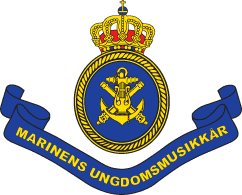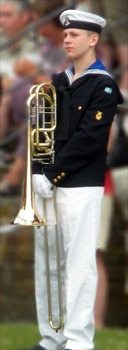

Uniform M/30
The History of the Band
The Royal Swedish Navy Cadet Band was started in 2002, in co-operation with the Royal Swedish Navy Band and the Armed Forces Music Centre. The Band has since been recognised as a band with musical quality and ability. The Band has received attention and honours from autorities in military music, as well as audience both in Sweden and abroad.
The Band is run by the non-profit organisation Marinens Ungdomsmusikkår, with a board consistiong of playing youth and adults knowledgeable in music and administration. The vision of the Band is to become a recognised part of Swedish military music, with the best possible musical quality and opportunity for the young musicians. The Band aims to develop and care for the Swedish wind music tradition through co-operation with other bands and musical bodies in Sweden and the world.
Major events
2005 Ystad International Military Tattoo, Sverige
2006 Eksjö Tattoo, Sverige
2006 Swedish Military Tattoo, Sverige
2008 Eksjö Tattoo, Sweden
2008 Hannover Musikparade der Nationen, Tyskland
2009 Bremen Musikschau der Nationen, Tyskland
2009 Polizei-Show Hamburg, Tyskland
2009 Fulda Military Tattoo, Tyskland
2010 Musikparade Germany; Frankfurt, Stuttgart, Erfurt, Munich, Tyskland
2010 Wedding of HKH Victoria and Prince Daniel, Sverige
2010 The Birmingham Tattoo, England
2011 Musikparade Germany; Schwerin, Rostock & Cottbus, Tyskland
2011 Malmö International Tattoo, Sverige
2011 Berlin Tattoo - das original, Tyskland
2012 The Rose Parade - Pasadena, California, USA
2012 Eksjö International Tattoo, Sweden
2012 "X Festival Internacional Banda de Musica" in Torrevieja, Spain
2013 Zürich Tattoo, Zürich, Switzerland
Uniform Modell 1930
The uniform of the Royal Swedish Navy Cadet Band has its own unique story which begins in the early days of the naval city Karlskrona and the Ship-cadet corps.
The ship-cadet corps was a group of youth who were taught sailing and other maritime skills aboard the large sailing ships in Sweden. The history of the ship-cadet corps began in 1685 and the corps with its musical performances was decommissioned in 1939. The corps had companies in Karlskrona, Stockholm and Marstrand.
The uniform was often quite simple. The trousers were sometimes sewn from sail cloth and could therefore be quite roomy. Under the collar, a scarf or råbandshalsduk was worn. Two of the things which have been kept through history are the emblem on the cap and the ribbon for the cap (topplänta). The emblem is an anchor, mirrored with respect to the one in use by other maritime bodies. The ribbon was used during climbs in the masts, fastened under the chin. It became tradition that the ribbon be fastened during parades ashore as well, a tradition that the Royal Swedish Navy Cadet Band keeps alive to this day.





The International Code of Signals
One of the oldest ways to communicate at sea is by signalling flags. Already in Admiral Nelson's time, it was common practise to relay messages during battle with the help of these flags. At the Battle of Trafalgar, he signalled to his fleet: “ENGLAND EXPECTS THAT EVERY MAN WILL DO HIS DUTY”.
The flags above spell out “Yankee-Zulu-Mike-Uniform-Kilo” which can be interpreted as “Spelled message follows: M U K”, giving the Swedish initials of the Marinens Ungdomsmusikkår



 Home
Home News ▾
News ▾ History
History